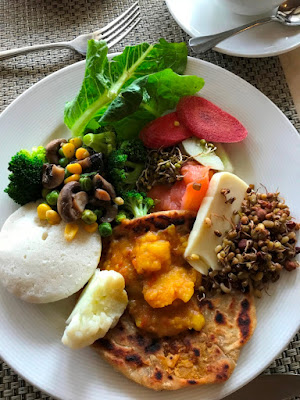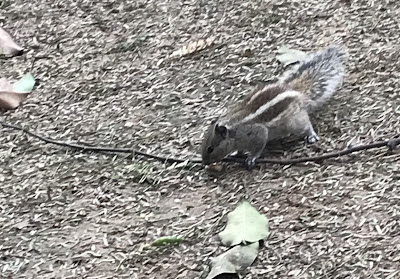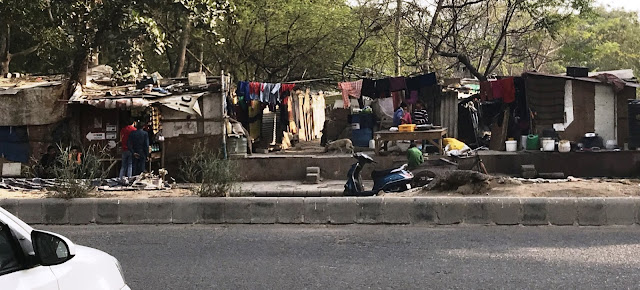I need to give you a brief introduction to the country before I begin our travelogue. Please do continue reading, or if you wish, skip down to the pictures! (Any word/phrase underlined and in blue is for clicking on to get more information on the subject.)
India is a land of astounding contrasts, within the country and in the world as a whole. It is the seventh largest country in the world in area, the second largest in population after China, and the largest democracy in population in the world.
It is a federal union of 29 states and 7 union territories, and each state is divided in to districts and smaller administrative divisions. The states were officially created when India became independent of Great Britain in 1947. Some were former governors' provinces of British India, others princely states, etc. The states were reorganized in 1956 based on linguistic lines. In essence, India is really an mix of 29 different countries as each of the states has at least one language of its own and specific cultures of its own, yet India functions as one democratic country.

Nava and I had thought that English was a major language in India and that many people spoke it daily. We were wrong. On the street in the northern cities we visited, we heard Hindi. People working in tourism spoke English but not the average person on the street. English is taught in many schools but there are differences in public vs private and regions where it is taught. English is also used often as a semi-official language so as not to choose one regional language as superior to another.
India has 22 official languages, which are, Bengali, Hindi, Maithili, Nepali, Sanskrit, Tamil, Urdu, Assamesse, Dogri, Kannada, Gujarati, Bodo, Manipuri (or Meitei), Oriya, Marathi, Santali, Telugu, Punjabi, Sindi, Malayalam Konkani, and Kashmir. Hindi is the official language of the central government and is spoken by many people in Northern India, it is not common in Southern India.
According to the census of India ,the total number of mother tongues spoken is 1652 (with dialect variations). However, only around 150 languages have a sizable speaking population People we met often spoke 4 or 5.
The Vindyha ranges of mountains from west to east divide northern and southern India. The southern area was more isolated in history and as a result has had fewer cultural influences from outside, whereas the northern region was invaded and populated by many different groups of people over time where groups intermingled and created an amazing cultural diversity, making northern India an incredible place to visit.
Nava had already bought her ticket through Emirates Airlines from Seattle west to Dubai (a 14 hour airplane trip) and then east to Delhi (another 3 hours). So I flew to Seattle from Boston on January 24 and we departed on January 29.
Emirates was wonderful--plenty of leg room in the regular economy section, the seat bottoms moved as well as the back so we could rest very well, great food (yes, I am saying that about an airline!!), an empty seat between us, and great movies in many languages--we both watched "Victoria and Abdul" as well as a movie about surfers from Gaza.
Dubai has developed into a large tourist destination and many people stay for several days on their way to another country.
Our layover in Dubai was a bit over two hours, but we were kept entertained by the art work and history as we walked around.
 |
| The airport sold cigarettes and alcohol--to people traveling out of the country. |
 |
| an example of a mural |
 |
| Part of a huge cute caricature mural |
 |
| About the creator of the mural |
 |
| a bit of the history |
Security was tight leaving the airport and I managed to lose my fitbit on the second major security check where I had to take it off as well as my watch. I'm not sure if I need to get another one right away..
About 1:30 a.m. Jan. 31, we landed in India. (India is 13.5 hours ahead of Seattle, 10.5 hours ahead of Boston, and 3.5 hours ahead of Israel. All of India is in the same time zone.)
 |
| with amazing hand signs of the Buddha |
The breakfast buffet included a selection of western and Indian food and we were delighted to try to new foods.
 |
| grilled tomatoes, sprounted fenugreek I think, paratha, mild tomato chutney, etc. |
 |
| Nava's choices |
 |
| An amazing lily bouquet in the hotel lobby. Flowers were everywhere! |
We pointed to our goal on a map to the driver of a tuktuk , negotiated a price, and headed out. A tuktuk, an "auto rickshaw" that seats the driver and two more. It usually is powered by CNG, compressed natural gas, which is more efficient and causes a lot less pollution. The ones powered by CNG are yellow and green.
Our first stop was the Lodi (Lodhi) Gardens, a public garden oasis in the middle of Delhi, containing the tombs of Lodi people who ruled the Delhi area in the 15th and 16th centuries.
 |
| What a variety of birds in the park! |
 |
| Part of the park in the dry season, after a low amount of rain in the monsoon season |
More buildings and natural settings:
 |
| Bara Gumbad and Mosque |
 |
 |
| A stream running through the park |
 |
| We then sat on one of the park benches and ate our lunch, packed from breakfast, and watched these tiny squirrels around us search for food |
Security is quite strong at the hotel. A gated fence surrounds the hotel area and a guard checks cars/buses that enter. At the one entrance to the hotel inside the fence, there is a place for bags to be checked electronically. Men are checked individually in place and women enter a small cubicle where a woman smiles and checks each of us individually. We asked our guide the next day about the security, and he did agree that it had picked up significantly since the attacks at five sites in September, 2008 with over 30 deaths.
We were just starting out on our next adventure when we remembered we forgot something and had to go through the same security ritual even tho we had just gone through it 15 minutes before. We were later to find out on our trip that we had to go through similar security in Mumbai and Jaipur hotels, I believe.
 |
| Mangosteen |
 |
| Rambutan |
 |
| A tuktuk traffic jam |
After a short break we headed out to walk a mile to the Bahai Lotus Temple, which an Indian-Israel-American friend in Bellingham recommended we see, and we soon realized it was the unusual building we saw from our hotel window.
 |
| The Bahai Lotus temple |
The Bahai Lotus Temple opened in December, 1986. The Bahai Faith is a relatively new monotheistic religion, created in the mid-1800s. The temple is open to people of all faiths and is one of the most visited buildings in the world. It is created in the shape of a lotus flower with 27 free-standing marble-clad "petals" arranged in clusters of three to form nine sides. It was stunningly beautiful and very simple inside.
In order to go inside, we had to take off our shoes, and like all temples we entered in India, we easily found our shoes when we returned.
It had been hazy most of the day, and we arrived closer to sunset, so it was hard to get good photos.
After a busy day, with a lot of walking--thank you for the health monitor on our IPhones--we went to bed early, excited to start our official tour the next day.


























